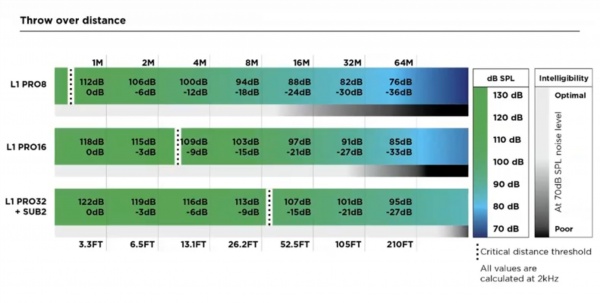Two L1 Pro8 or One L1 Pro16
One L1 Pro16
The L1 Pro16 can project twice as far in every direction as the L1 Pro8. Another way to view that, at distances over 25 feet (8 meters), the L1 Pro16 can be as much as +9 dB SPL louder than an L1 Pro8. +10 dB SPL is perceived as twice as loud.
- Note
- Two identical systems (e.g., two L1 Pro8) may be up to +3 dB SPL louder than one. (Not twice as loud).
Because all L1 Pro systems have 180-degree horizontal dispersion, a single system can often reach the whole audience area. You don't need two systems, as you do with other systems with narrower horizontal dispersion.
If you take two L1 Pro8 systems and separate them, you can get more coverage than one. (More = the distance between them, side-to-side), but you don't get more projection in front of them. You can expect the L1 Pro16 to cover twice the area of two L1 Pro8 systems and provide substantially more bass.
Two L1 Pro8
Reasons to choose two L1 Pro8 over a single L1 Pro16:
- For two performers: Run the systems independently, with each performer heard through only one L1 Pro.
- You and your audience get the benefits of the Cocktail Party Effect
- Two or more performers. Use two systems to split the vocal microphones and increase your gain before feedback. Here's why:
- For every doubling of the number of microphones heard through one loudspeaker, you lower your gain before feedback by up to -3 dB
- For every doubling of the number of loudspeakers connected to a microphone, you lower your gain before feedback by up to -3 dB
- If you run two microphones into two loudspeakers (dual mono), you are doing both of the above
- If you split the microphones so each microphone is heard through only one loudspeaker, you increase your gain before feedback compared to running all the microphones through one or more loudspeakers
- Stereo. If you are running prerecorded music in stereo (e.g., backing tracks), you need two systems to play stereo
